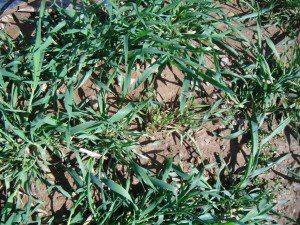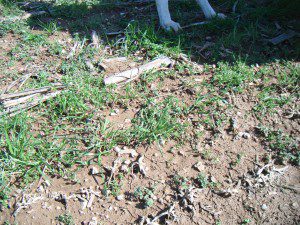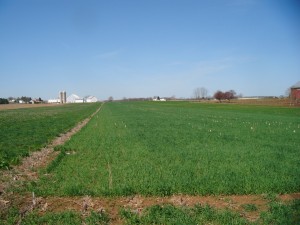Cover crops survived the winter somewhat inconsistently this year, as we could see at the cover crop walk at the Steven Stoltzfus farm in Manheim, Lancaster County, PA (sponsored by Penn State Extension and NRCS). With what became almost a six month winter this year, starting with an unseasonably frigid November, we got a taste of what farmers face most years in more northern eco-zones.
Most of the cover crops at this location were planted in late September, a few weeks earlier than normal for Southeastern PA. Winter survival was still spotty, with the

rye and triticale showing the best survival, while crimson clover and ryegrass showed poor survivability, even in mixes. The clover was planted during a dry spell in which there was no rain until three weeks after planting, which made for later emergence and poor establishment.

In mixes like ryegrass-triticale-crimson clover at the Manheim location, nothing survived but the triticale. Injury may have been from both pure exposure to cold and freezing and thawing action of the soil. In our Leola, Lancaster County, PA research plots, ryegrass also showed poor survivability, even where it was in a mixture with triticale or barley and got some shelter from the hardier crop. Though this is not typical for our region, it’s important to realize that ryegrass may die back while small grains in the same field show little winter injury.
In the Leola plots, we are also seeing some leaf burn, but overall decent survival of crimson clover. There were no straight stands, however – it was always in combination with small grains and ryegrass.
In some areas, annual ryegrass died back a bit and might look sparse now, but if there is still some green growth and spring conditions are right, it can continue to grow, thicken, and fill in through May. In harsh conditions, the success of ryegrass may be difficult to predict, since it exhibits both susceptibility – to winter diseases like snow mold and winterkill – and resilience. If ryegrass is able to put on decent growth, it can be one of the most beneficial cover crops out there in terms of ground cover, soil building organic matter, and nutrient-catchment – and is pretty much the most economical. If used for grazing, it is also one of the highest quality and most palatable grasses, even through early heading. It’s also more forgiving in terms of harvest window than rye.

If the ryegrass starts to put on too much growth before winter (more than 6-8 inches), it’s usually better to take a clipping before winter for best survival.
There have been varying reports of success for overwintering of ryegrass, even within Lancaster County alone, and much of this depends on the variety (some are much hardier), the planting date, the field, what it was planted with, and even the seed lot.
Plots where daikon radish had been left few traces of residue or organic matter, but the radish’s “soil-sterilizing”/”bio-fumigant” properties, typical of brassicas, left the soil almost weed free. Radishes do winterkill even in a typical year, so they are often used as part of a cover crop mix, with oats or another cool season annual.
Northern growers often want to use radishes, but don’t have time in the short growing season. To grow a substantial taproot, they need to get established by late summer, even in our Mid-Atlantic region.
Speak to an expert at King’s AgriSeeds now at 1-717-687-6224 or email us at [email protected].

2 Comments. Leave new
In New York the Triticale had a hard time but will be ok if planted deep enough. The rye where planted in 1.5 inch deep rows looks good. The rye broadcast spread in the fall looks bad.
Yes, when planted deeper the roots can get more securely established, and aren’t as likely to get heaved out with freezing and thawing. Also, broadcasting doesn’t give you the same seed to soil contact that drilling it in would, so the stand is at a disadvantage to begin with in the fall.